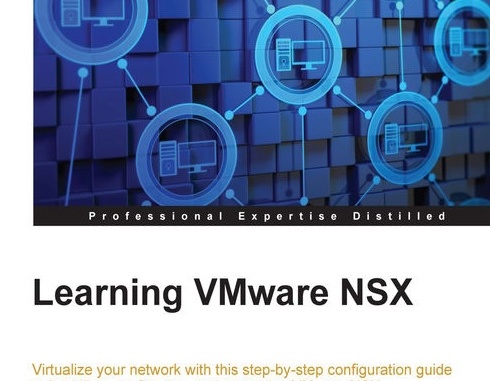
This book is one of the first books about VMware NSX 6.2. Being to the point and not too big a book, this book is really one of the resources you should have in your library if you’re using VMware NSX.
Let us have a quick look at the book contents

This book has nine chapters:
Chapter 1: An introduction into Network Virtualization concepts and NSX-V. It also includes the only current (albeit inofficial) reference for NSX 6.2 Configuration Maximums.
Chapter 2: An introduction into NSX components which is a simple and smooth entrance to the world of VMware NSX. This includes also a good explanation of the VXLAN concepts. It also gives an overview of the much anticipated new feature: Cross-vCenter NSX.
Chapter 3: This chapter explains installing and configuring each component in a step-by-step approach for example how do you install and integrate the NSX Manager as well as the NSX Controllers. Hereafter this chapter explains how to prepare your compute clusters to be able to use the NSX features and how to license your NSX environment. It also gives an overview of the NSX manager admin panel and the NSX Manager section in vSphere Web Client.
Chapter 4: This is a big chapter! This is about installing and configuring main services of NSX, like: Logical Switches, Logical Router, Logical Firewall and L2 Bridges. Just like chapter 3 it comes in a step-by-step format accompagnied by the neccesary screenshots.
Chapter 5: This chapter is all about the Edge Services Gateway (ESG) functionalities. It is a complete guide to ESG services such as: Routing, DHCP and DHCP Relay, Load Balancing and VPNs. It also includes some auxiliary functions such as: how to re-deploy the ESGs and how to create a trunk interface. You can expect the same format as the previous chapters.
Chapter 6: This chapter describes three functions: the Service Composer, the Data Security function and the Network function extensibility. Another big chapter that needs a lot of focus because it explains some complex configurations, but at the same time it explains them smoothly with all the neccesary screenshots.
Chapter 7: This chapter is all about Monitoring your NSX environement by using different available tools in NSX such as: Trace Flow and Flow Monitoring.
Chapter 8: This chapter is about the auxiliary functionalities: backup/restore your NSX environment and configure a Syslog Server for your NSX Manager. It also includes some NSX Controllers Cluster tasks.
Chapter 9: This is the conclusion. It is a short chapter which includes all the important sources for more deep-dive knowledge of VMware NSX (acording to the author’s point of view) as well as an introduction to the available VMware HOLs of NSX.
Why this book stands out from the crowd:
This book is one of the first books, if not the actual first, about NSX 6.2. It also includes a inofficial Configuration Maximums guide which is not available from VMware (I looked for it myself for couple of days and didn’t find anything till I was referenced to this book by Fouad El Akkad).
To me, this book is a good example of a complete step-by-step guide for most of the daily tasks you need to know to administer NSX 6.2. If you’re an administrator or a new NSX implementer, you should own this book.
The book takes you in a smooth learning curve, which is suitable for a new NSX administrator, starting from the simple A-B-C information till the deep technical steps needed for each function.
Recommendations for future Editions:
- Chapter 2: A single chapter for all fundamental services is not enough in my humble opinion. It needs to be separated in two or more chapters. But it might be the Author point of view to keep the book short.
- Chapter 6: A single chapter for Data Security and Service Composer is not enough too. I’d recommend putting each in a separate chapter.
- I’d recommend the Author to add a couple of chapters for technical deep dive about NSX components and how they integrate with each other, like how Duncan Epping and Cormac Hogan did in their Essential Virtual SAN. I know that this might be out of the book scope according to the Author, but doing so it’d make the book more rich and would answer a lot of the questions that may come in reader mind without searching for answers in other places.
- I’d recommend the Author too add a couple of chapters for Designing and Architecting NSX environment. I know that this might be out of the book scope according to the Author, but doing so it’d make the book as a No.1 Reference for all NSX Engineers, wither a day-to-day administrator or a NSX Solution Architect.

Leave a Reply